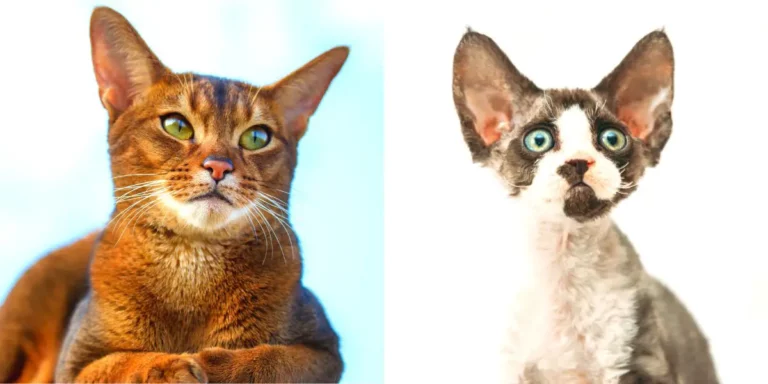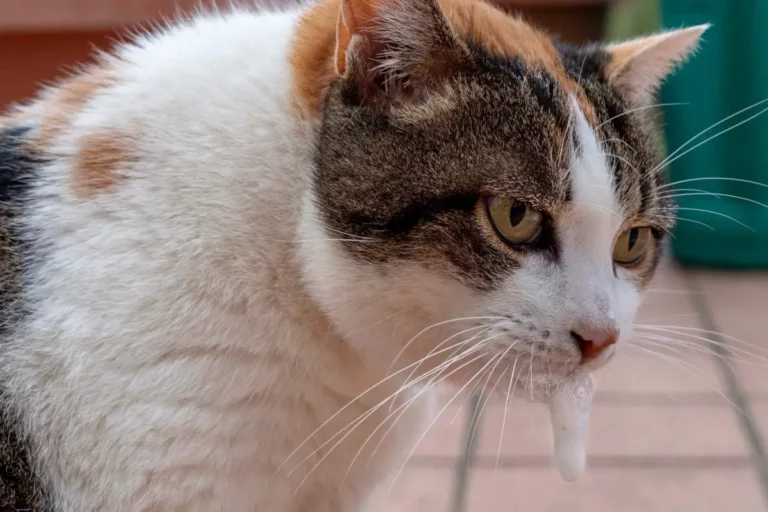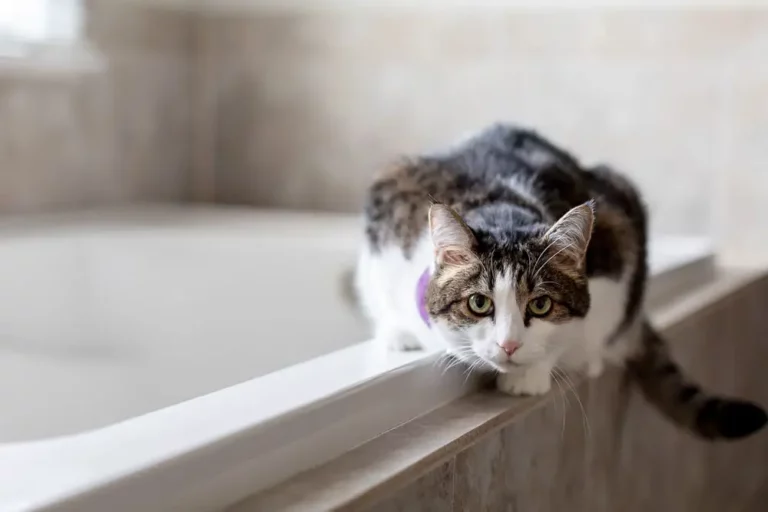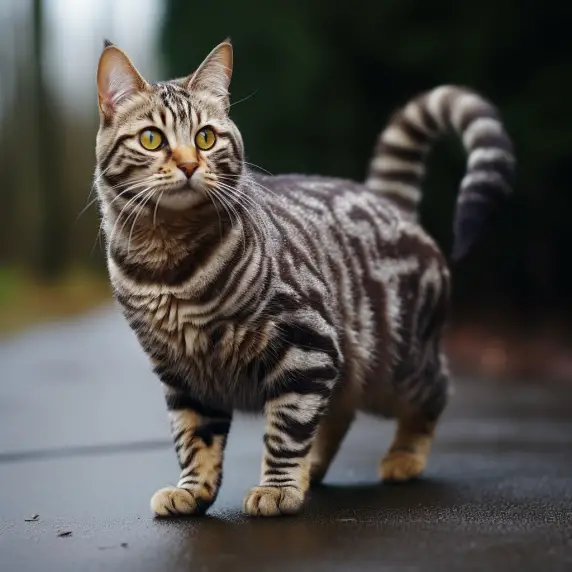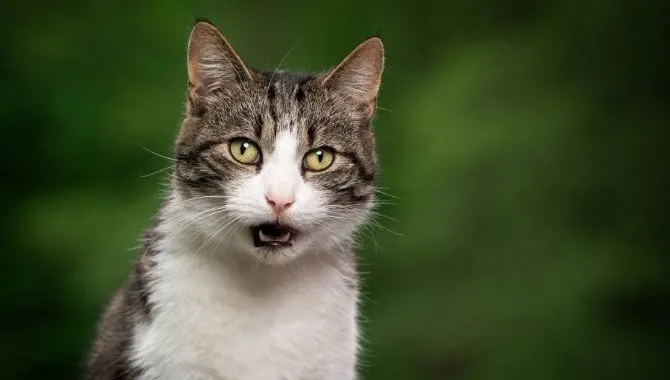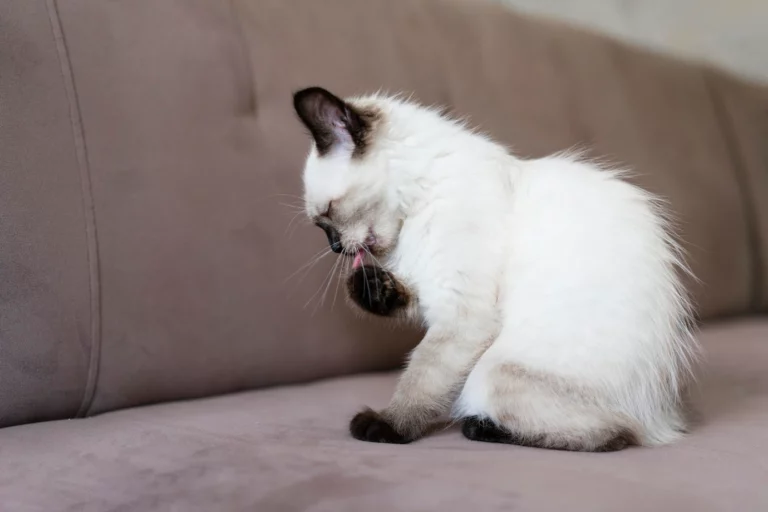Step-by-Step Ragdoll Cat Grooming & Care Guide
Owning a Ragdoll cat can be an absolute joy, with their affectionate nature and striking beauty. However, one responsibility that comes with owning these beautiful cats is ensuring their fluffy coats stay in top shape. That’s where Ragdoll cat grooming comes in.
Proper grooming is not just about aesthetics; it’s also crucial for your Ragdoll’s health and comfort. In this comprehensive guide, we will walk you through all the steps and provide all the necessary knowledge to keep your Ragdoll’s coat looking its absolute best.
Let’s dive in!
Key Insights At a Glance
- Ragdoll cats have a medium-long, plush, and silky coat that requires regular grooming to keep it at its best.
- Ragdolls shed less compared to other long-haired breeds but still need weekly brushing to prevent matting and hairballs.
- Choosing the right grooming tools, like a slicker brush and comb, is essential in maintaining the health and appearance of your Ragdoll’s coat.
- Bathing a Ragdoll should be done occasionally, only when necessary, with a gentle cat-friendly shampoo.
- Regular grooming sessions can be a bonding time between you and your Ragdoll, contributing to their overall well-being.
- Monitoring skin and coat during grooming sessions helps in the early detection of any potential health concerns like skin issues or parasites.
- Regular grooming contributes significantly to your Ragdoll’s health and comfort, reducing the risk of hairballs and skin issues.
- When done right, grooming doesn’t have to be a stressful process for you or your Ragdoll.
In short: With the right tools and approach, grooming your Ragdoll cat can be an enjoyable and rewarding activity that keeps your furry friend feeling good and looking their best.
Understanding the Ragdoll’s Unique Coat
As owners of these fluffy companions, we need to understand what makes the Ragdoll’s coat so unique. The Ragdoll cat has a medium to long-length coat that is plush and silky to the touch. Unlike some other long-haired breeds, their coat lacks an undercoat, which leads to less shedding and matting.
However, this doesn’t mean they’re entirely free from these issues.
Their fur, especially around their neck and hindquarters, can get particularly thick and prone to knotting. Regular brushing is therefore a must to keep your Ragdoll’s coat looking its best.
Additionally, Ragdolls have a seasonal coat, with more significant shedding expected during the transition from winter to spring as they shed their winter coat. This period may require extra grooming efforts to manage the shedding and prevent matting.
It’s also worth noting that the color and pattern of a Ragdoll’s coat can impact its texture and thickness. For example, darker areas of fur may be slightly thicker and require more attention during grooming.
Remember, the health of your Ragdoll’s coat is not just about aesthetics. It is also an indicator of their overall health.
A well-groomed, shiny coat often signals a healthy cat, while changes in texture, excessive shedding, or skin issues could point toward underlying health issues. Hence, regular grooming sessions also double up as a health check, helping you detect any potential problems early.
No products found.
Essential Tools for Grooming Your Ragdoll
To provide your Ragdoll cat with the best grooming experience, you’ll need to equip yourself with the right tools. The appropriate grooming tools not only make the process easier and more efficient, but they’re also gentler on your cat’s skin and coat, leading to a more pleasant experience for your feline friend.
Here’s a list of grooming tools you should consider:
- Slicker Brush: This is a must-have tool for any Ragdoll owner. Its fine, short wires are perfect for detangling and removing loose hairs, reducing the chance of hairballs.
- Steel Comb: A steel comb can be used after the slicker brush to catch any missed tangles or mats. The different-spaced teeth allow for thorough combing, including finer areas like the face and paws.
- De-Matting Tool: Despite your best efforts, sometimes mats can form. In such cases, a de-matting tool can help you gently and safely remove the mats without causing discomfort to your Ragdoll.
- Grooming Wipes: These are perfect for quick clean-ups, especially around the face and paws. They can help remove any food particles or dirt, keeping your Ragdoll fresh between grooming sessions.
- Cat Nail Clippers: Regular nail clipping is essential to prevent overgrowth and scratching-related accidents. Get a pair of good quality cat nail clippers that allow for precise cuts.
- Cat Toothbrush and Toothpaste: Dental health is also a part of grooming. Brushing your Ragdoll’s teeth can prevent dental diseases and promote overall health.
Having the right Ragdoll cat grooming kit will ensure you’re well prepared to keep your pet looking and feeling their best. But remember, it’s not just about having the tools – knowing how to use them properly is equally important.
Always be gentle and patient during grooming sessions to make the experience positive for your Ragdoll.
Ragdoll Cat Grooming Brush
Choosing the right brush is an essential aspect of Ragdoll cat grooming. The type of brush you use can make a big difference in both the effectiveness of the grooming session and the comfort of your cat. For Ragdolls, the ideal brush is one that can penetrate their thick coat without causing discomfort or damage.
One such brush that has proven effective for Ragdolls is the slicker brush. The slicker brush has thin, fine bristles that are perfect for penetrating the Ragdoll’s dense fur, detangling any knots, and removing loose hairs.
When using a slicker brush, it’s crucial to use gentle, short strokes to avoid pulling on their fur and causing any discomfort.
In addition to the slicker brush, a steel comb with wide-set teeth can be a valuable tool for Ragdoll cat grooming. It can reach deeper into their fur, catching any tangles or mats that the slicker brush may have missed. The wide-set teeth allow for easy detangling without pulling on the skin.
When picking a brush for your Ragdoll, look for one with a comfortable handle and flexible bristles. This will ensure that both you and your cat have a positive grooming experience.
Remember, the goal is not just to keep your Ragdoll’s coat looking beautiful but also to strengthen your bond with your feline friend through these grooming sessions.
Ragdoll Cat Grooming Kit
Equipping yourself with the right Ragdoll cat grooming kit is key to maintaining your furry friend’s beautiful coat and overall well-being. A well-stocked kit can make grooming sessions more efficient, comfortable, and even enjoyable for your cat. Let’s look at the key components of a comprehensive Ragdoll cat grooming kit:
- Grooming Brushes and Combs: As we discussed earlier, a slicker brush and a steel comb are vital tools for maintaining a Ragdoll’s coat. They help remove loose fur and prevent mats and tangles.
- Nail Clippers: Regular nail trimming is a necessary part of Ragdoll grooming. Look for clippers specifically designed for cats to ensure a safe and easy trimming session.
- Pet-friendly Wipes: These can be helpful for quick clean-ups, especially around your cat’s face and paws.
- Shampoo and Conditioner: Select products specifically designed for cats, as they have a different skin pH than humans. Opt for a gentle formula that won’t strip your Ragdoll’s coat of its natural oils.
- Ear Cleaner: Ragdolls, like all cats, can accumulate wax and dirt in their ears. A gentle, vet-recommended ear cleaner can help keep their ears clean and healthy.
- Dental Products: Dental care is often overlooked in grooming. Include cat-friendly toothpaste and a toothbrush in your kit to maintain your Ragdoll’s oral health.
- Hairball Remedy: Regular grooming can help reduce hairballs, but including a hairball remedy in your kit can offer additional protection, especially during shedding seasons.
By assembling a thorough Ragdoll cat grooming kit, you’ll be prepared for all aspects of grooming, helping to ensure your Ragdoll remains as healthy and happy as possible.
No products found.
A Step-by-Step Guide to Brushing Your Ragdoll
Keeping your Ragdoll’s luxuriously soft and silky fur in tip-top shape involves regular brushing. This not only keeps your feline friend looking her best, but it also provides an opportunity to check for any skin issues or parasites.
Here’s a step-by-step guide to brushing your Ragdoll effectively:
1. Preparation:
Make sure you have your grooming kit ready, particularly your slicker brush and steel comb. Choose a quiet and comfortable location where your Ragdoll can relax during the grooming session.
2. Getting Your Ragdoll Comfortable:
Some cats may be nervous about being groomed, especially if they are not used to it. Start by petting your cat to make her relaxed.
3. Start Brushing:
Start brushing from the head, moving towards the tail. Brush in the direction of the hair growth. Be gentle and ensure you’re not pulling on the hair, which can cause discomfort.
4. Check for Mats and Tangles:
As you brush, check for mats and tangles, particularly in areas such as the underarms, groin, and behind the ears. These can be gently teased out with a comb, but if they’re very tight, you may need to seek professional help to avoid hurting your cat.
5. Use the Steel Comb:
After you’ve thoroughly brushed your cat with the slicker brush, follow up with the steel comb. This will remove any remaining loose hairs and give the coat a nice finish.
6. Reward Your Cat:
After the grooming session, reward your cat with her favorite treat. This will help her associate grooming sessions with positive experiences, making future grooming sessions easier.
7. Regular Schedule:
Make sure to keep a regular grooming schedule, ideally brushing your Ragdoll at least once a week. However, during the shedding seasons, more frequent brushing may be necessary.
Remember, each cat is unique, and some may require more frequent grooming than others. Always pay attention to your cat’s behavior during grooming sessions and adjust as needed to make sure the experience is pleasant and stress-free for both of you.
Ragdoll Grooming Styles
Ragdolls, known for their glorious, medium-length, silky coats, often do well with their natural look. However, there are several Ragdoll grooming styles that some cat owners choose to employ for various reasons including manageability, comfort, and health.
1. Lion Cut:
The lion cut involves shaving most of the cat’s body, leaving fur on the head, neck, paws, and tail tip. This can be beneficial during hot weather, for cats prone to heavy matting, or for those with certain medical conditions. Though it might seem drastic, rest assured, the fur will grow back!
2. Teddy Bear Cut:
Also known as a ‘puppy cut’, this style trims the fur all over the cat’s body to a uniform length, typically about half an inch. This cut retains more fur than a lion cut, but still reduces the maintenance required for a full coat.
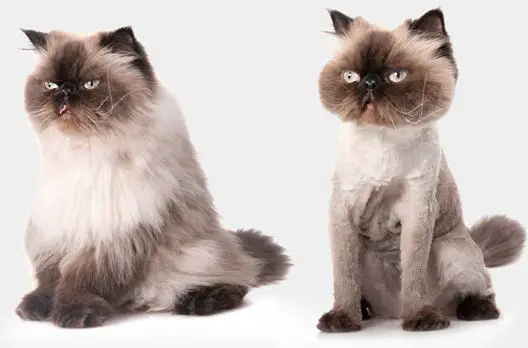
3. Belly Shave:
The belly shave leaves most of the cat’s fur intact but removes the fur on the belly and possibly the hindquarters. This can be a good option for cats prone to matting in these areas, or for older or overweight cats who have trouble grooming themselves.
4. Comb Cut:
The comb cut trims the fur to leave it 1-2 inches in length, maintaining the fluffy appearance of the cat’s coat but reducing the likelihood of matting and the amount of fur shed around your home.
Before deciding to shave or trim your Ragdoll’s fur, it’s important to remember that their coat is part of their identity and offers protection against environmental factors.
Any grooming decisions should be made with the cat’s best interests at heart, and professional guidance is always recommended to ensure the process is done safely and correctly.
Always consider your cat’s comfort, well-being, and the necessity of the cut before proceeding.
The Role of Diet in Maintaining Your Ragdoll’s Coat
Feeding your Ragdoll a balanced and nutritious diet is fundamental to their overall health and specifically their coat’s condition. A well-fed Ragdoll will have a glossy, smooth, and tangle-free coat, a clear sign of good health.
Let’s delve into the critical dietary components that contribute to a beautiful, healthy coat:
1. High-quality Protein:
Cats, including Ragdolls, are obligate carnivores. This means they require a diet high in animal-based proteins. Protein helps maintain their skin’s health and ensures their fur remains thick and glossy. Look for cat foods where high-quality sources of protein like chicken, fish, or beef are listed as the primary ingredients.
2. Essential Fatty Acids:
Omega-3 and Omega-6 fatty acids play a vital role in maintaining your Ragdoll’s coat health. These fatty acids nourish the skin, reduce inflammation, and ensure your Ragdoll’s coat stays shiny and lush. Look for foods enriched with these nutrients, or consider a supplement if necessary.
3. Vitamins and Minerals:
Specific vitamins and minerals, such as Vitamin A, B vitamins, Zinc, and Biotin, contribute significantly to skin and coat health. These nutrients aid in cell growth and repair, promote healthy hair follicles and can help keep your Ragdoll’s coat looking its best.
4. Hydration:
Water plays a key role in your cat’s overall health, including their skin and coat. Encourage your Ragdoll to stay hydrated by always providing fresh water and consider including wet food in their diet.
Remember, before making any drastic changes to your Ragdoll’s diet, it’s best to consult with your vet to ensure it meets all their nutritional needs. Regular vet checks can also help identify any dietary deficiencies early, keeping your cat, and their coat, in the best possible condition.
Do Ragdolls Need Haircuts?
One common question many Ragdoll owners have is whether their feline friends need haircuts. The answer largely depends on your cat’s personal grooming habits and your lifestyle.
Unlike other long-haired cat breeds, Ragdolls’ hair doesn’t tend to mat or clump easily because it’s more like rabbit fur in texture. This means regular, thorough brushing often keeps their coat in good condition, without the need for a haircut. However, some situations might warrant a trim.
1. Comfort and Hygiene:
During hot months, a shorter haircut can provide relief from the heat for your Ragdoll. Additionally, if your cat struggles to keep themselves clean – especially around the rear end – a trim can help maintain hygiene.
2. Ease of Grooming:
A haircut can make your grooming routine simpler if your Ragdoll particularly dislikes being brushed or if they have developed some mats that are hard to remove.
3. Health Reasons:
In some cases, a vet may recommend a haircut for specific skin conditions or medical treatments.
Before deciding on a haircut, it’s essential to consider your Ragdoll’s comfort and safety. Some cats may become stressed during the cutting process, and an inexperienced person can accidentally injure the cat.
Therefore, if you opt for a haircut, it’s best done by a professional groomer or a vet who understands the cat’s needs and behavior.
Lastly, remember that your Ragdoll’s beautiful coat is one of its defining features. Any changes to it, such as a haircut, should prioritize their comfort and health above aesthetic considerations.
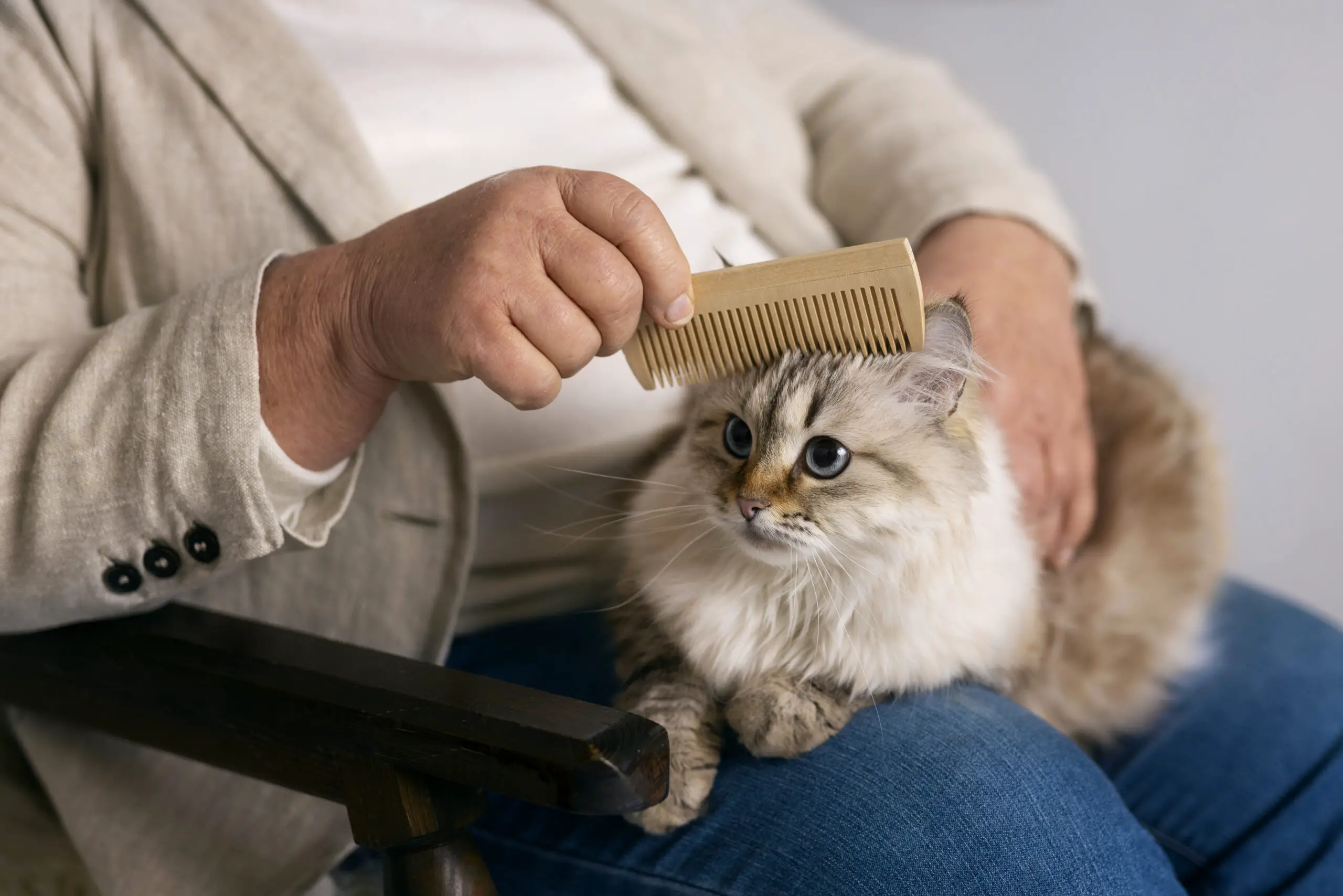
Bathing Your Ragdoll: Techniques and Tips
While cats are known for their self-cleaning habits, Ragdolls might occasionally need a bath due to their long, plush coat. The process of bathing a cat can be a little daunting, especially if you’re a first-time cat owner. But with a few tricks up your sleeve, it can be an enjoyable bonding time with your furry friend.
Here’s a step-by-step guide on how to bathe your Ragdoll:
1. Preparation:
Before the bath, brush your Ragdoll’s coat to remove any loose hair or tangles. Prepare everything you’ll need – a gentle cat-friendly shampoo, a large towel, a non-slip mat for the tub or sink, and a cup or handheld sprayer for rinsing.
2. Fill the Tub:
Ragdolls prefer warm environments, so use lukewarm water for the bath. The water level should be shallow, about 3 to 4 inches. Place the non-slip mat at the bottom to provide a secure footing for your cat.
3. Slow and Steady:
Slowly introduce your Ragdoll to the water. Talk in a soothing voice to comfort them and let them explore the water with their paws first.
4. Apply the Shampoo:
Gently apply the shampoo, starting from the neck and working your way down the body. Be careful to avoid the face and ears.
5. Rinse:
Rinse thoroughly with clean, lukewarm water. Make sure no shampoo residue is left, as it can irritate the skin and be licked off during grooming.
6. Drying:
Wrap your Ragdoll in a towel immediately after the bath and pat dry. Avoid rubbing as it can cause tangles. If your Ragdoll tolerates it, you can use a blow-dryer on the lowest heat setting to help dry the coat faster.
Remember, patience is key when bathing a Ragdoll. Some may enjoy the water, while others might need a little coaxing. Ensure the experience is positive and stress-free, rewarding them with treats and praises during and after the bath.
Note: Frequent baths are not necessary for Ragdolls and can strip their coat of natural oils. Usually, a bath every few months or when they get particularly dirty is enough. Always consult with your vet if you’re unsure about your Ragdoll’s specific needs.
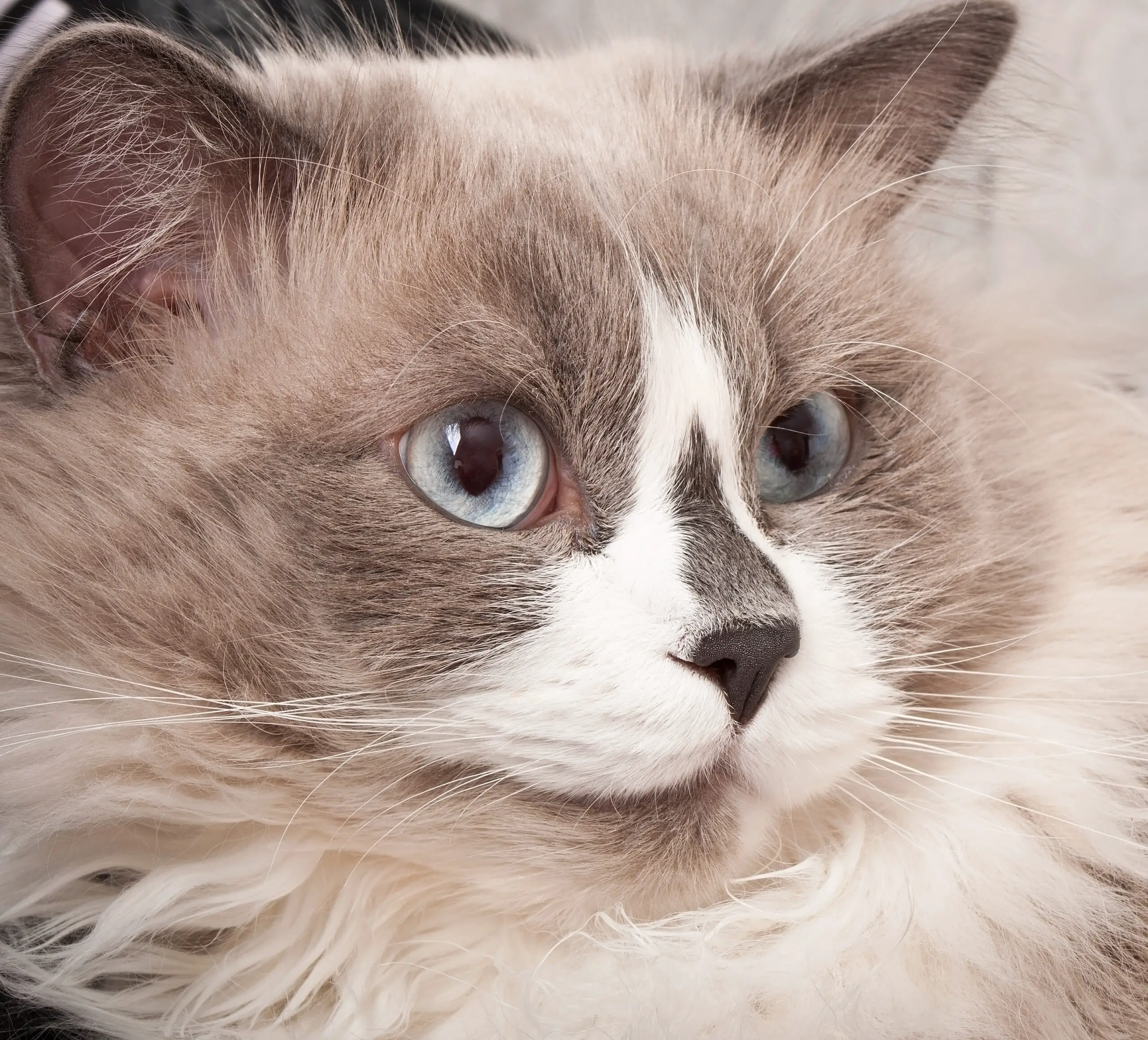
Understanding When (and When Not) to Shave Your Ragdoll
Shaving a Ragdoll cat is not typically necessary and should be considered a last resort. Their fur does not mat as easily as other long-haired breeds thanks to its silky texture. However, there might be circumstances where shaving could become necessary.
Consultation with a professional groomer or a vet is crucial before taking such a step.
When might shaving be necessary?
- Severe Matting: If your Ragdoll’s coat has severe matting that can’t be addressed with grooming, shaving might be the only option left to alleviate your cat’s discomfort. Mats can pull on the skin causing pain and may hide skin conditions or parasites.
- Medical Reasons: Sometimes, for certain surgical procedures or medical treatments, parts of your Ragdoll’s coat might need to be shaved.
- Heat Relief: Some believe that shaving a cat’s coat can provide relief from the heat during the summer months. However, a cat’s coat is designed to insulate them from both cold and hot weather. Shaving could disrupt this natural temperature regulation.
Why should you avoid shaving your Ragdoll?
- Skin Protection: A Ragdoll’s coat offers protection from sunburn and cold weather. Shaving exposes the skin, making it vulnerable to weather extremes and sun damage.
- Natural Temperature Regulation: Cats regulate their body temperature through their coat. A shaved coat can disrupt this process, leading to overheating in summer or hypothermia in winter.
- Stress for Your Cat: The process of shaving can be stressful and even traumatic for some cats. It should be avoided unless absolutely necessary.
If shaving becomes necessary, it’s usually best to leave it to a professional groomer or vet. They have the experience and the right tools to shave a cat safely without causing injury.
Note: If you’re dealing with mats, consider seeking professional help before deciding to shave. Often, mats can be carefully cut or combed out without resorting to a full shave. Regular brushing is the best preventive measure against mats forming in your Ragdoll’s coat.
Dental Care for Your Ragdoll
Dental care is an often overlooked, yet crucial aspect of Ragdoll cat grooming. Dental disease can lead to serious health issues if left unattended. Ragdolls are not unique in this regard, but as a responsible Ragdoll owner, maintaining their oral health should be part of your regular grooming routine.
Why is dental care important for your Ragdoll?
- Prevents Dental Diseases: Regular brushing can prevent dental diseases like gingivitis and periodontitis, which can lead to tooth loss if not treated.
- Enhances Overall Health: Poor dental health can lead to other health problems, such as heart, kidney, and liver diseases, due to bacteria from the mouth entering the bloodstream.
- Promotes Good Eating Habits: Oral pain due to dental issues can affect your cat’s eating habits. Regular dental care ensures that your Ragdoll can eat comfortably.
Steps to provide dental care for your Ragdoll:
- Regular Brushing: Brush your Ragdoll’s teeth regularly using a cat-specific toothbrush and toothpaste. Never use human toothpaste as it can be toxic to cats.
- Dental Check-ups: Regular dental check-ups with a vet can help identify any budding oral issues and treat them before they worsen.
- Dental Treats and Toys: Certain treats and toys are designed to promote dental health by naturally cleaning your cat’s teeth as they chew.
- Healthy Diet: Feeding your Ragdoll a balanced diet can also contribute to good oral health. Some vets recommend specific dental diets designed to reduce plaque build-up.
Remember, it’s never too late to start a dental routine with your Ragdoll. With patience and persistence, you can help ensure a happy, healthy life for your feline friend. As always, consult with your vet about the best dental care practices for your specific pet.
Nail Care for Ragdoll Cats
One aspect of Ragdoll cat grooming that requires careful attention is nail care. Ragdolls have sharp, retractable claws that are essential for their comfort, mobility, and safety. Maintaining your Ragdoll’s nails is a key component of their overall well-being.
Why is nail care important for your Ragdoll?
- Prevents Overgrowth: Overgrown nails can curve into your cat’s paw pads, causing pain and possible infection.
- Protects Furniture: Regular nail trims can help save your furniture from being damaged by your cat’s natural need to scratch.
- Promotes Good Hygiene: Dirt and debris can accumulate under your cat’s nails, leading to potential hygiene issues.
Steps to provide nail care for your Ragdoll:
- Regular Trimming: Depending on your cat’s lifestyle and how quickly their nails grow, aim to trim their nails every 10-14 days.
- Use the Right Tools: Use a specially designed cat nail clipper for the job. Human nail clippers can split and fracture the nail.
- Handling Technique: Get your Ragdoll used to having their paws handled. Start with gentle massage, and once they are comfortable, proceed to expose their nails by pressing their paw pads.
- Safe Trimming: Cut the nail below the quick (the pink part inside the nail where the blood vessels are), just where it starts to curve. Cutting into the quick will cause pain and bleeding.
- Reward: Offer a treat or petting as a reward after each successful trimming session. This helps make the experience more positive for your cat.
- Scratching Posts: Providing scratching posts at home will allow your Ragdoll to naturally wear down their nails and satisfy their instinct to scratch.
Remember, if you’re uncertain or uncomfortable trimming your cat’s nails, it’s best to seek professional help. A vet or a professional groomer can demonstrate the process, and with practice, you’ll be able to manage your Ragdoll’s nail care routine confidently.
Eye and Ear Care for Your Ragdoll
Grooming your Ragdoll cat is not just about maintaining their beautiful coat; it also includes taking care of their eyes and ears. Here’s a comprehensive guide on how to keep your Ragdoll’s eyes and ears clean and healthy.
Eye Care for Ragdolls:
Ragdolls are known for their striking blue eyes, which need regular attention to keep them clear and free of infections.
- Check Regularly: Check your cat’s eyes daily for any signs of discharge, redness, or inflammation.
- Cleaning: Use a clean, damp cotton ball to gently wipe away any crust or discharge from the corner of your cat’s eyes. Always wipe from the inside corner outward, and use a separate cotton ball for each eye to avoid spreading any potential infection.
- Avoid Direct Contact: Never touch the eyeball directly, and avoid using any products not specifically designed for use in cats’ eyes.
- Annual Check-ups: Your vet should examine your cat’s eyes during their annual check-up to ensure there are no underlying issues.
Ear Care for Ragdolls:
Ragdoll cats have semi-long hair that can sometimes grow inside their ears, potentially leading to wax build-up or ear infections.
- Check Regularly: Watch out for excessive scratching, shaking of the head, or a foul odor – these could be signs of an ear infection. Regularly check your cat’s ears for any discharge, redness, or inflammation.
- Cleaning: Use a cat-specific ear cleaner and a cotton ball or gauze pad. Gently wipe the inside of the ear flap and the opening of the ear canal. Never insert anything into your cat’s ear canal as it could cause injury or push debris further in.
- Trim Hair: If your Ragdoll has hair growing in the ear canal, carefully trim it with round-tip scissors to prevent the accumulation of wax and debris.
- Consult a Vet: If you notice any signs of an ear infection or are unsure about how to clean your cat’s ears, consult your vet.
Remember, maintaining regular eye and ear care is an important part of your Ragdoll cat grooming routine, contributing to your cat’s overall health and comfort.
Addressing Common Grooming Problems
Grooming is an essential part of your Ragdoll’s care, but sometimes, it can come with a few challenges. Here, we’ll discuss some of the common grooming problems and their solutions to ensure your Ragdoll cat grooming experience is as smooth as your cat’s silky coat.
1. Matting and Knotting:
Ragdolls have a luxurious, semi-long coat that, while less prone to matting than some other long-haired breeds, can still form knots if not properly cared for.
- Regular Brushing: Daily brushing is crucial in preventing mats and tangles. A slicker brush or a de-matting comb can help detangle knots without causing pain or discomfort to your cat.
- Mat Removal: If mats do form, it’s essential to remove them gently to avoid hurting your cat. You can use a mat splitter or a de-matting comb to do this. If a mat is too tight to remove at home, consult a professional groomer or your vet.
2. Resistance to Grooming:
Some Ragdolls may not enjoy being groomed, especially when it comes to more invasive tasks like teeth or ear cleaning.
- Positive Reinforcement: Using treats and praise can make grooming a more positive experience for your Ragdoll. Always end the grooming session on a positive note.
- Gradual Introduction: Introduce grooming gradually, starting with shorter sessions and building up over time.
- Consistent Routine: Try to establish a consistent grooming routine, so your cat knows what to expect.
3. Over-grooming:
Sometimes, a Ragdoll might over-groom a certain area due to stress or an underlying medical condition.
- Consult a Vet: If you notice your cat over-grooming, it’s best to consult a vet to rule out any medical problems. They can also offer advice on managing stress in cats.
By understanding these common problems and how to address them, you can ensure that your Ragdoll cat grooming routine is a positive, bonding experience for both you and your feline friend.
Related:
Frequently Asked Questions
How often should a Ragdoll be groomed?
Ragdolls have a semi-long, silky coat that typically doesn’t mat as much as other long-haired breeds. However, it’s still recommended to brush your Ragdoll at least once or twice a week to remove loose hairs and prevent possible matting. Regular grooming also helps to distribute natural oils, keeping their coat healthy and shiny.
Is a Ragdoll cat high maintenance?
Ragdolls are often considered low to moderate in terms of maintenance. They are typically calm and easy-going, which can make grooming sessions more manageable. Their fur, while long, is less prone to matting compared to other long-haired breeds.
However, regular brushing, dental care, and eye and ear cleaning are still necessary to keep them in good health.
Do Ragdoll cats get matted?
Although Ragdoll’s coat is less prone to matting than other long-haired breeds, they can still get mats if their coat is not regularly brushed. This is especially true in areas where the fur is thicker or where the cat can’t groom themselves, such as the armpits or lower abdomen.
Do Ragdoll cats leave hair everywhere?
As with any long-haired breed, Ragdolls can shed quite a bit, especially during seasonal changes. Regular brushing can help reduce the amount of hair they shed around your home. Investing in a good vacuum cleaner and lint rollers can also be beneficial.
What can I do if my Ragdoll cat dislikes being groomed?
If your Ragdoll is resistant to grooming, try to make it a positive experience. Use treats and praise to reward your cat during and after grooming. Start with short grooming sessions and gradually increase the duration as your cat becomes more comfortable.
Always be gentle and patient during grooming sessions. If your cat continues to resist grooming, it may be helpful to seek advice from a professional groomer or your veterinarian.
Conclusion: Establishing a Regular Grooming Routine
In conclusion, grooming your Ragdoll cat is more than just keeping their coat looking its best. It’s a fundamental aspect of their overall health and well-being.
Establishing a regular grooming routine helps to keep your Ragdoll looking and feeling their best while also providing an opportunity to monitor for any changes in their skin or coat that might indicate a health concern.
Through regular grooming, you’ll also strengthen your bond with your feline friend, as it can be a calm and soothing experience for both of you.
Start with the essentials, and as you become more comfortable, you can incorporate other elements such as nail trimming, dental care, and even specialized grooming styles.
Remember to always make grooming a positive experience for your Ragdoll, using patience, kindness, and treats to foster a cooperative and enjoyable atmosphere.
With the insights from this guide, you’re now well-equipped to manage your Ragdoll’s grooming routine. Here’s to a happy, healthy, and well-groomed feline friend!


